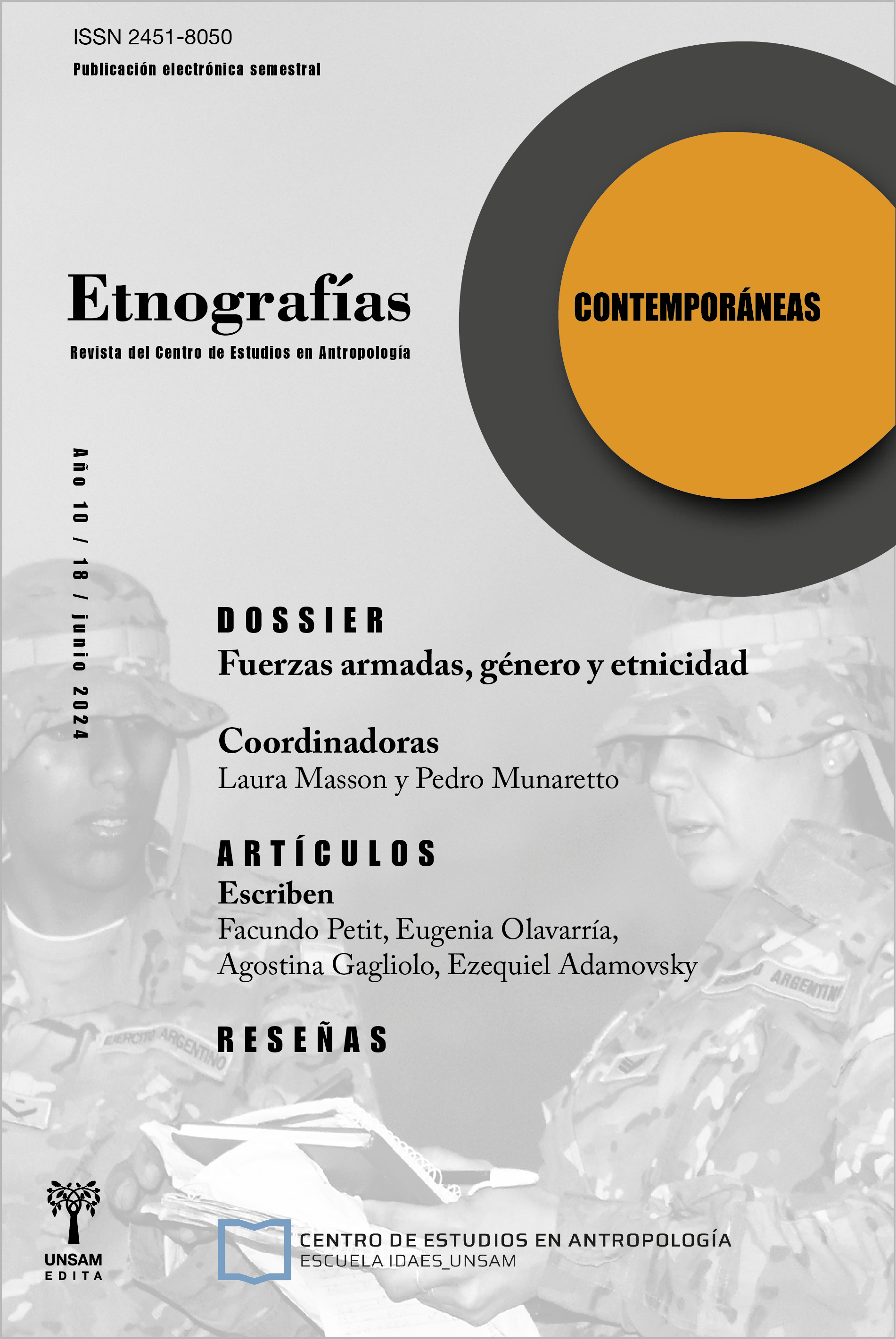“One of the guys”: Women, Agency, and The Transformations of the Argentine Army
Keywords:
military women, Argentine Army, female agencyAbstract
In this article, I examine institutional life in the Argentine Army today from the perspective of female soldiers, with particular emphasis on the opportunities for agency available to these women in the army and the possibilities of institutional change they unintentionally produce. I show how female soldiers have made possible the concept of a military subject open to values from different dimensions of their identities. The agency of these female soldiers does not contain any explicit intentionality to resist or subvert institutional norms and values associated with military masculinity; rather, this agency is to be found in the different kinds of individuality that female soldiers bring into view inside and outside the army. Through their practices, ideas, and conceptions of military activity, female soldiers pave the way for discussing a key dimension in the redefining of the relations among the armed forces, the state, and society at large in present-day Argentina: soldiers as citizens. In this way, the experiences of women in the Argentine Army mirror internal changes within the military institution, where they also chart the scope, ambiguity, and contradictions present in the ongoing democratization of Argentine society.
References
Abu-Lughod, L. (1990). The Romance of Resistance: Tracing Transformations of Power through Bedouin Women, American Ethnologist, Vol. 17, N° 1, pp. 41-55.
Acker, J. (1990). Hierarchies, Jobs, Bodies: A Theory of Gendered Organizations, Gender and Society, Vol. 4, N° 2, pp. 139-158.
Acuna, C. y Smulovitz, C. (1995). “Militares en la transición argentina”, en Acuna, Carlos (ed.): Juicio, castigos y memorias: Derechos humanos y justicia en la política argentina. Nueva Visión. pp. 21-98.
Badaró, M. (2009). Militares o ciudadanos: La formación de los oficiales del Ejército Argentino. Prometeo.
Britton, D. M. (2000). The Epistemology of the Gendered Organization, Gender and Society, Vol. 14, N° 3, pp. 418-434.
Butler, J. (1993). Bodies That Matter: On the Discursive Limits of “Sex”. Routledge.
–––(2004). Deshacer el género. Routledge.
Canelo, P. (2010). ¿Un nuevo rol para las Fuerzas Armadas? Políticos y militares frente a la protesta social y los derechos humanos: Argentina, 1995-2002. Consejo Latinoamericano de Ciencias Sociales.
Carreiras, H. (2006). Gender and the Military: Women in the Armed Forces of Western Democracies. Routledge.
Castro, C. (1990). O espírito militar. Jorge Zahar Editor.
Castro, C. y Leirner, P. (eds.) (2009). Antropología dos militares. Fundaçao Getulio Vargas Editora.
Connell, R. W. (1995). Masculinities. University of California Press.
Dandeker, Ch. (2003). “Femmes combattantes”: Problemes et perspectives de l’intégration des femmes dans l’armée britannique, Revue Française de Sociologie, Vol. 44, N° 4, pp. 735- 758.
Diamint, R. (ed.) (1999). Control civil y fuerzas armadas en las nuevas democracias Latinoamericanas. Nuevohacer.
Donadio, M. (2009). La mujer en las instituciones armadas y policiales: resolución 1325 y operaciones de paz en América Latina. Red de Seguridad y Defensa de América Latina.
Douglas, M. (1991). Purity and Danger: An Analysis of Concepts of Pollution and Taboo. Routledge.
Dumont, L. (1970). Homo hierarchicus. Gallimard.
Faur, E. (2008). Desafíos para la igualdad de género en Argentina. Programa de las Naciones Unidas para el Desarrollo.
Fitch, S. (1998). The Armed Forces and Democracy in Latin America. The Johns Hopkins University Press.
Foucault, M. (2000). “The Subject and Power”, en Faubion, James D. (ed.): Power: The Essential Works of Foucault, vol. 3: 1954-1984. New York, New Press. pp. 325-348.
Frederic, S. (2008). Los usos de la fuerza pública: Debates sobre militares y policías en las ciencias sociales de la democracia. Buenos Aires, Universidad Nacional de General Sarmiento - Biblioteca Nacional.
––– (2013). Las trampas del pasado. Las Fuerzas Armadas y su integración al Estado democrático en Argentina. Fondo de Cultura Económica.
–––(2015). Women’s Integration into the Argentine Armed Forces and Redefinition of Military Service. What does Military Democratization mean?, Dynamiques Internationales, N° 11, pp. 1-23.
Frühstück, S. (2007). Uneasy Warriors: Gender, Memory and Popular Culture in the Japanese Army. University of California Press.
Gill, L. (1997). Creating Citizens, Making Men: The Military and Masculinity in Bolivia, Cultural Anthropology, Vol. 12, N° 4, pp. 527-550.
Guber, R. (2004). De chicos a veteranos. Memorias argentinas de la guerra de Malvinas. Antropofagia.
Gusterson, H. (1999). Feminst Militarism, PoLAR: Political and Legal Anthropology Review, Vol. 22, N° 2, pp. 17-26.
Hauser, O. (2011). ‘We Rule the Base because We’re Few’: ‘Lone Girls’ in Israel’s Military, Journal of Contemporary Ethnography, Vol. 40, N° 6, pp. 623-651.
Hershberg, E. y Agüero, F. (eds.) (2005). Memorias militares sobre la represión en el Cono Sur. Siglo XXI.
Kondo, D. K. (1990). Crafting Selves: Power, Gender, and Discourses of Identity in a Japanese Workplace.University of Chicago Press.
Lazarus-Black, M. (2001). Law and the Pragmatics of Inclusion: Governing Domestic Violence in Trinidad and Tobago, American Ethnologist, Vol. 28, N° 2, pp. 388-416.
López, E. y Pion-Berlin, D. (1996). Democracia y cuestión militar. Quilmes, Universidad Nacional de Quilmes.
Lucero, M. (2009). Las mujeres en las fuerzas armadas argentinas. Breve análisis sobre su participación y estado actual de la situación, Unidad de Investigación sobre Seguridad y Cooperación Internacional (UNISCI). Discussion Papers, N° 20, pp. 36-49.
Mahmood, S. (2005). Politics of Piety: The Islamic Revival and the Feminist Subject. Princeton University Press.
Masson, L.(2017). Women in the Military in Argentina: Nationalism, Gender, and Ethnicity, en Demos, Vasilikie y Segal, Marcia Texler (eds.): Gender Panic, Gender Policy (Advances in Gender Research, Vol. 24). Emerald Publishing Limited, pp. 23-43.
––– (comp.) (2020). Militares argentinas. Evaluación de Políticas de Género en el ámbito de la defensa. Universidad de la Defensa Nacional.
May, T. (2005). Gilles Deleuze: An Introduction. Cambridge University Press.
Merry, S. (1995). Resistance and the Cultural Power of Law, Law and Society Review, Vol. 29, N° 1, pp. 11-26.
Ministerio de Defensa de la República Argentina (2010). Informe sobre la integración de la mujer en las Fuerzas Armadas. Ministerio de Defensa.
Novick, M.; Rojo, S. y Castilla, M. V. (eds.) (2008). El trabajo femenino en la post-convertibilidad: Argentina, 2003-2007. . Comisión Económica para América Latina y el Caribe.
Ortner, S. B. (1996). Making Gender: The Politics and Erotics of Culture. Beacon.
–––(2006). Anthropology and Social Theory: Culture, Power and the Acting Subject. Duke University Press.
Ranciere, J. (2000). Le partage du sensible. Esthétique et politique. La fabrique.
Sain, M. (2010). Los votos y las botas: Estudios sobre relaciones cívico-militares en la democracia argentina. Prometeo.
Sasson-Levy, O. (2003). Feminism and Military Gender Practices: Israeli Women Soldiers in ‘Masculine’ Roles, Social Inquiry, Vol. 73, N° 3, pp. 440-465.
Scott, J. W. (1996). Only Paradoxes to Offer: French Feminists and the Rights of Man. Harvard University Press.
Segal, M. W. (1995). Women’s Military Roles Cross-Nationally: Past, Present and Future, Género y Sociedad, Vol. 9, N° 6, pp. 757- 775.
Sion, L. (2008). Peacekeeping and the Gender Regime: Dutch Female Peacekeepers in Bosnia and Kosovo, Journal of Contemporary Ethnography, Vol. 37, N° 5, pp. 561-585.
Sorin, K. (2006). Las mujeres en las fuerzas armadas francesas: Integración versus conflicto, en Pinch, F. C.; MacIntyre, A. T.; Browne, P. and Okros, A. C. Okros (eds.): Challenge and Change in the Military: Gender and Diversity Issues. Wing. pp. 76-96.
Stiehm, J. H. (1982). The Protected, the Protector, the Defender, Women’s Studies International Forum, Vol. 3-4, N° 5, pp. 367-376.
Theidon, K. (2008). Reconstructing Masculinities: The Disarmament, Demobilization and Reintegration of Former Combatants in Colombia, Human Rights Quarterly, Vol. 31, N° 1, pp. 1-34.
Winslow, D. y Dunn, J. (2002). Women in the Canadian Forces: Between Legal and Social Integration, Current Sociology, Vol. 50, N° 5, pp. 641-667.
























